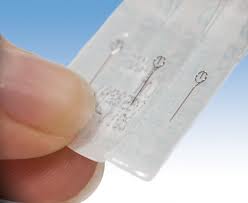 How does your allergy manifest?
How does your allergy manifest?
Whether you suffer from nasal allergies, asthma, eosinophilic esophagitis, urticaria and/or eczema, Allergy Relief Acupuncture can help you.
Allergies occur when your immune system produces an IgE-type antibody in response to proteins (antigens) from outside the body (inflammation). The antigen/antibody combinations go on to harm the respiratory tract lining &/or skin cells which release the histamine that produces the itch, runny nose/eyes, sneeze and cough you experience. In Western medicine, therapies include avoidance, antihistamines, steroids and (epinephrine).
Any agent may trigger allergy’s exaggerated immune response: environmental allergens such as pollens, grasses, trees, molds; animal danders or proteins; dust mites; foods, especially eggs, milk, nuts, shellfish, soy; insect venoms; oral and injectable pharmaceuticals; and chemicals such as latex. Rare individuals may even produce a true allergic skin reaction to the sun.
How is the treatment done? 
In Allergy Relief Acupuncture,1–4 of these needles are placed under the ear’s skin and remain in place for 3 weeks, while the allergen is avoided as much as possible. After needle removal, those with milder allergies may introduce very small amounts of the allergen (such as food, pets, etc), and we monitor for response. The goal is to attenuate or eliminate allergic responses to the allergen
Those with very severe reactions and anaphylaxis must continue strict allergen avoidance & carrying epinephrine, antihistamines and/or steroids: the goal is to attenuate possible accidental allergen exposure.
This technique was developed by Nader Soliman MD. Starting in 2002, and refined since 2009, Dr. Soliman combined his expertise in Auricular Acupuncture Therapy (ear acupuncture) with his knowledge of muscle testing [2] to produce this highly effective desensitization technique (SAAT: Soliman Auricular Allergy Treatment [1]). In 2014, Dr. Soliman published a series of 40 patients treated with this technique who afterwards demonstrated allergy desensitization both by patient history and objective blood or skin testing [1].
This therapy may also be beneficial as adjunctive support for ongoing inflammatory conditions and subclinical infections.
In 2014, Dr. Villanova trained in this new technique, and has since helped dozens of patients attenuate or even eliminate their allergic conditions. This technique can serve as stand-alone therapy. So, unlike body acupuncture and Chinese herbal medicine, you need not engage in comprehensive evaluation and management for Allergy Relief Acupuncture to be effective.
Please contact Dr. Villanova if you have questions about whether or not Allergy Relief Acupuncture / Allergy Desensitization may benefit you.
Allergy Desensitization Testimonials
1. “A Comparison Study of the Effectiveness of SAAT (Soliman’s Auricular Allergy Treatment) Approach and Nogier’s Allergy Treatment Technique.” Nader Soliman. Medical Acupuncture.June 2014: 167-172.
2. “Correlation of applied kinesiology muscle testing findings with serum immunoglobulin levels for food allergies.” Schmitt WH Jr1, Leisman G. Int J Neurosci.1998 Dec: 96(3-4):237-44.
X
These brief overviews of conditions represent distillations of basic and current medical reviews from the following sources:
[1] Conventional Medical Sources
“Harrison’s Principles of Internal Medicine: Volumes 1 and 2, 18th Edition”. Dan Longo Anthony Fauci, Dennis Kasper, Stephen Hauser, J. Jameson, Joseph Loscalzo. McGraw-Hill Professional; (July, 2011)
Medscape eMedicine Physician’s online resource. Various review articles:
Allergic and Environmental Asthma: an Overview of Asthma
William F Kelly III, MD Associate Professor of Medicine, Uniformed Services University of the Health Sciences; Staff physician, Division of Pulmonary/Critical Care Medicine, Department of Medicine, Walter Reed National Military Medical Center
Allergic Rhinitis
Javed Sheikh, MD Assistant Professor of Medicine, Harvard Medical School; Clinical Director, Division of Allergy and Inflammation, Clinical Director, Center for Eosinophilic Disorders, Beth Israel Deaconess Medical Center
Food Allergies
Scott H Sicherer, MD Professor of Pediatrics, Jaffe Food Allergy Institute, Mount Sinai School of Medicine of New York University
Atopic Dermatitis
Brian S Kim, MD Clinical Instructor, Department of Dermatology, Hospital of the University of Pennsylvania, Perelman School of Medicine, University of Pennsylvania
Seborrheic Dermatitis
Samuel T Selden, MD Assistant Professor Department of Dermatology Eastern Virginia Medical School; Consulting Staff, Chesapeake General Hospital; Private Practice
Psoriasis
Jeffrey Meffert, MD Assistant Clinical Professor of Dermatology, University of Texas School of Medicine at San Antonio
Urticaria
M Scott Linscott, MD, FACEP Adjunct Professor of Surgery (Clinical), Division of Emergency Medicine, University of Utah School of Medicine
Cholinergic Urticaria
Robert A Schwartz, MD, MPH Professor and Head, Dermatology, Professor of Pathology, Pediatrics, Medicine, and Preventive Medicine and Community Health, University of Medicine and Dentistry of New Jersey-New Jersey Medical School
[2], [3]
- “Acupuncture Energetics: A Clinical Approach for Physicians”. Joseph M. Helms. Medical Acupuncture Publishers; 1st Edition. (1995)
- “Foundations of Chinese Medicine: A Comprehensive Text for Acupuncturists and Herbalists”. Giovanni Maciocia. Churchill Livingstone; 2 Edition (July, 2005).
- “Diagnosis in Chinese Medicine: A Comprehensive Guide”. Giovanni Maciocia. Churchill Livingstone; 1st Edition (January, 2004).
4. “Chinese Scalp Acupuncture”. Jason Ji-shun Hao, Linda Ling-zhi Hao and Honora Lee Wolfe. Blue Poppy Press; 1stEdition. (November, 2011).
5. Ege MJ, Mayer M, Normand AC, Genuneit J, Cookson WO, Braun-Fahrländer C, et al. Exposure to environmental microorganisms and childhood asthma. N Engl J Med. Feb 24 2011;364(8):701-9. [Medline]
6. Tsai JD, Chang SN, Mou CH, Sung FC, Lue KH. Association between atopic diseases and attention-deficit/hyperactivity disorder in childhood: a population-based case-control study. Ann Epidemiol. Apr 2013;23(4):185-8. [Medline].
7. JPEN J Parenter Enteral Nutr. 2012 Jan;36(1 Suppl):68S-75S. doi: 10.1177/0148607111426276
8. Rubio-Tapia A, Kyle RA, Kaplan EL, et al. Increased prevalence and mortality in undiagnosed celiac disease. Gastroenterology. 2009;137:88-93.
9. Thompson T. Gluten contamination of commercial oat products in the United States. N Engl J Med. 2004;351:2021-2022.
10. Häuser W, Janke KH, Klump B, Gregor M, Hinz A. Anxiety and depression in adult patients with celiac disease on the gluten free diet. World J Gastroenterol. 2010;16:2780-2787.
11. Am. J. Epidemiol. (2013) 178 (12): 1721–1730 doi:10.1093/aje/kwt234
12. Addolorato G, Di Guida D, De Rossi G, et al. Regional cerebral hypoperfusion in patients with celiac disease. Am J Med. 2004;116:312-317.
- Sapone A, Lammers KM, Casolaro V, et al. Divergence of gut permeability and mucosal immune gene expression in two glutenassociated conditions: celiac disease and gluten sensitivity. BMC Med. 2011;9:23.
- Biesiekierski JR, Newnham ED, Irving PM, et al. Gluten causes gastrointestinal symptoms in subjects without celiac disease: a double-blind randomized placebo-controlled trial. Am J Gastroenterol. 2011;106:508-514.
- Yamini D, Pimentel M. Irritable bowel syndrome and small intestinal bacterial overgrowth. J Clin Gastroenterol. 2010;44:672-675.
13. Wahnschaffe U, Schulzke J-D, Zeitz M, Ullrich R. Predictors of clinical response to gluten-free diet in patients diagnosed with diarrhea-predominant irritable bowel syndrome. Clin Gastroenterol
Hepatol. 2007;5:844-850.
- Hadjivassiliou M, Grunewald RA, Chattopadhyay AK, et al. Clinical, radiological, neurophysiological and neuropatholgical characteristics of gluten ataxia. Lancet. 1998;352:1582-1585.
- Hadjivassiliou M, Boscolo S, Davies-Jones A, et al. The humoral response in the pathogenesis of gluten ataxia. Neurology. 2002;58:1221-1226.
- Dieterich W, Ehnis T, Bauer M, et al. Identification of tissue transglutaminase as the autoantigen of celiac disease. Nat Med. 1997;7:797-801.
- Korponay-Szabo IR, Halttunen T, Szalai Z, et al. In vivo targeting of intestinal and extraintestinal transglutaminase 2 by coeliac autoantibodies. Gut. 2004;53:641-648.
- Hadjivassiliou M, Maki M, Sanders DS, et al. Autoantibody targeting of brain and intestinal transglutaminase in gluten ataxia. Neurology. 2006;66:373-377.
14. Tengah CP, Lock RJ, Unsworth DJ, Wills A. Multiple sclerosis and occult gluten sensitivity. Neurology. 2004;62:2326-2327.
15. Hadjivassiliou M, Sander DS, Grünewald RA. Multiple sclerosis and occult gluten sensitivity. Neurology. 2005;64:933-934.
16. Lever R, MacDonald C, Waugh P, Aitchison T. Randomised controlled trial of advice on an egg exclusion diet in young children with atopic eczema and sensitivity to eggs. Pediatr Allergy Immunol. Feb 1998;9(1):13-9. [Medline].
17. Branum AM, Lukacs SL. Food allergy among children in the United States. Pediatrics. Dec 2009;124(6):1549-55. [Medline].
18. Fleischer DM, Burks AW, Vickery BP, Scurlock AM, Wood RA, Jones SM, et al. Sublingual immunotherapy for peanut allergy: a randomized, double-blind, placebo-controlled multicenter trial. J Allergy Clin Immunol. Jan 2013;131(1):119-27.e1-7. [Medline]. [Full Text].
19. Hand L. Probiotics may protect infants from allergy, but not asthma. Medscape Medical News [serial online]. August 19, 2013;Accessed August 25, 2013. Available at http://www.medscape.com/viewarticle/809604.
20. Elazab N, Mendy A, Gasana J, Vieira ER, Quizon A, Forno E. Probiotic Administration in Early Life, Atopy, and Asthma: A Meta-analysis of Clinical Trials. Pediatrics. Aug 19 2013;[Medline].
- O’Connel RA. SPECT brain imaging in psychiatric disorders: current clinical status. In: Grünwald F, Kasper S, Biersack HJ, Möller HJ, eds. Brain SPECT Imaging in Psychiatry. Berlin: de Gruyter; 1995:35-57.
- Grasby PM, Bench C. Neuroimaging in mood disorders. Curr Opin Psychiatry. 1997;10:73-78.
